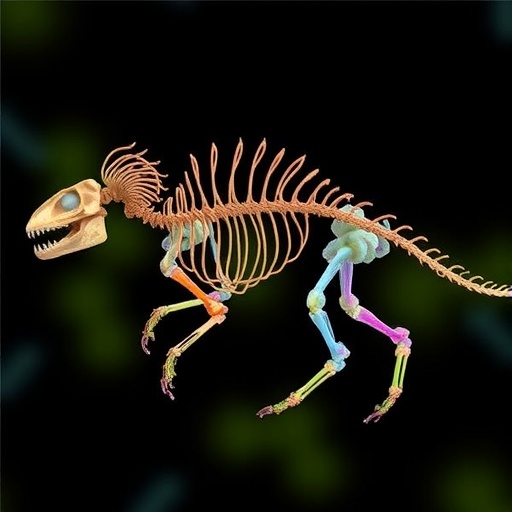
In the complex world of marine biology, the study of mitochondrial genomes offers a critical window into the evolutionary history of various species. A recent investigation into the mitochondrial genomes of the sand crab, Albunea symmysta, illuminates the intricate gene rearrangements that characterize this enigmatic crustacean. Conducted by a team of researchers led by Li et al., this study provides a comprehensive analysis that not only deepens our understanding of the phylogenetic relationships within the Anomura infraorder but also sets the stage for future research into decapod evolutionary biology.
Sand crabs, belonging to the infraorder Anomura, are fascinating organisms that inhabit coastal ecosystems. Their morphological adaptations to their sandy environments make them a unique subject of study in evolutionary biology. By analyzing the mitochondrial genomes of Albunea symmysta, the researchers aimed to uncover the underlying genetic mechanisms that contribute to the species’ adaptation and evolutionary trajectory. The results revealed significant gene rearrangements that are thought to play a crucial role in the evolutionary flexibility of these crustaceans.
Mitochondrial DNA (mtDNA) plays a pivotal role in understanding phylogenetics due to its maternal inheritance and rapid mutation rates, which make it a valuable tool for tracing lineage diversification. The researchers collected samples of Albunea symmysta from various locations in its natural habitat, ensuring a diverse representation of genetic material. This broad sampling allowed for a more robust analysis of the mitochondrial genome and its evolutionary implications.
One of the key findings of the study was the identification of unique gene rearrangements within the mitochondrial genomes of sand crabs. These rearrangements may be linked to adaptations that enhance survival in a dynamic and often challenging coastal environment. The significance of these genomic alterations cannot be understated, as they may provide insights into the evolutionary pressures faced by this species over time. Adaptation is a fundamental concept in evolutionary biology, and gene rearrangement serves as one mechanism through which organisms can respond to environmental challenges.
Furthermore, the study explored the phylogenetic relationships among various families within the Anomura infraorder. By placing Albunea symmysta within a broader comparative framework, the authors were able to clarify the evolutionary pathways that have led to the current diversity of decapod crustaceans. The relationships identified could potentially reshape our understanding of how these species have evolved in response to both biotic and abiotic factors throughout geological time.
Beyond the immediate findings about Albunea symmysta, the research contributes to a larger body of knowledge regarding mitochondrial genome evolution in crustaceans. The implications of gene rearrangements extend beyond mere curiosity; they can inform conservation strategies and ecological management efforts. Understanding the genetic basis of adaptability in species like the sand crab is essential, especially in the context of rapidly changing ocean climates and habitat destruction.
As part of their methodology, the research team employed a variety of genomic sequencing techniques to detail the complete mitochondrial genome of Albunea symmysta. This approach not only provided a comprehensive genetic framework for the study but also highlighted the potential for advanced genomic technologies in modern evolutionary research. The power of these methodologies lies in their ability to unravel genetic complexities that were previously beyond reach.
Among the various gene families analyzed, the researchers found particular interest in the genes responsible for energy production and metabolic processes. These genes are essential for the organism’s survival, especially in fluctuating environmental conditions typically encountered in sandy habitats. The study suggested that changes in mtDNA could signify adaptive responses to these stressors, reinforcing the concept that evolutionary change is often driven by environmental pressures.
The phylogenetic tree constructed from the mitochondrial data revealed intriguing relationships between Albunea symmysta and other decapod species. It demonstrated that despite physical differences, there are underlying genetic connections that reflect shared evolutionary histories. This tree serves not only as a roadmap for Albunea symmysta‘s lineage but also as a visual representation of the intricate tapestry of life that characterizes the Anomura infraorder.
What’s particularly compelling about this study is how it integrates traditional ecological knowledge with cutting-edge genomic research. The authors advocate for a multidisciplinary approach to studying marine organisms, emphasizing that the fusion of evolutionary biology, ecology, and genomics can lead to a more holistic understanding of species’ adaptations. This synergy is essential for developing effective conservation policies as the impacts of human activity on marine ecosystems become increasingly pronounced.
In addition to its implications for evolutionary biology, this research carries importance for understanding biodiversity and species resilience. As the climate changes and human activities continue to affect marine habitats, species that possess greater genetic diversity and flexibility may be better poised to survive. Thus, research like that conducted by Li et al. is critical in identifying those species and understanding their unique adaptations, ultimately guiding conservation efforts.
The findings from the study highlight the evolving nature of scientific inquiry in the field of genetics. As more researchers delve into the realms of mitochondrial genomics, discoveries will undoubtedly continue to emerge that challenge existing paradigms. The intricate relationship between gene rearrangement and evolutionary success in organisms like sand crabs underscores the importance of genetic research in decoding life’s history on Earth.
In conclusion, the analysis of mitochondrial genomes in Albunea symmysta reveals a trove of information about evolutionary pathways and adaptations within the Anomura infraorder. As the field of evolutionary biology progresses, it is studies like this that pave the way for deeper insights into the mechanisms of evolution, the nature of adaptation, and the connections between diverse species. The implications extend far beyond academic curiosity, holding significant potential for conservation efforts and the sustainable management of marine ecosystems.
The study by Li and colleagues serves as a crucial reminder of the remarkable complexities of life and the genetic underpinnings that enable species to respond to their environments. As marine scientists continue to peel back the layers of genetic information, we can expect to uncover more about the intricacies of evolution and the survival strategies of our planet’s diverse organisms.
Subject of Research: Mitochondrial genomes and gene rearrangements in Albunea symmysta
Article Title: Gene Rearrangement in the Mitochondrial Genomes of the Sand Crabs Albunea symmysta (Anomura:Hippoidea) with Insights into Phylogenetic Relationships in the Anomura (Crustacea: Decapoda).
Article References: Li, B., Li, J., He, J. et al. Gene Rearrangement in the Mitochondrial Genomes of the Sand Crabs Albunea symmysta (Anomura:Hippoidea) with Insights into Phylogenetic Relationships in the Anomura (Crustacea: Decapoda). Biochem Genet (2025). https://doi.org/10.1007/s10528-025-11213-0
Image Credits: AI Generated
DOI: 10.1007/s10528-025-11213-0
Keywords: Mitochondrial genome, gene rearrangement, sand crab, Albunea symmysta, phylogenetics, Anomura, evolutionary biology, decapoda.
Tags: Albunea symmysta evolutionary studyAnomura phylogenetic relationshipscoastal ecosystem organismsdecapod evolutionary historyevolutionary flexibility in speciesgene rearrangements in crustaceansgenetic mechanisms in adaptationmarine biology researchmaternal inheritance in mtDNAmitochondrial DNA in phylogeneticsmitochondrial genome analysissand crab adaptation mechanisms



